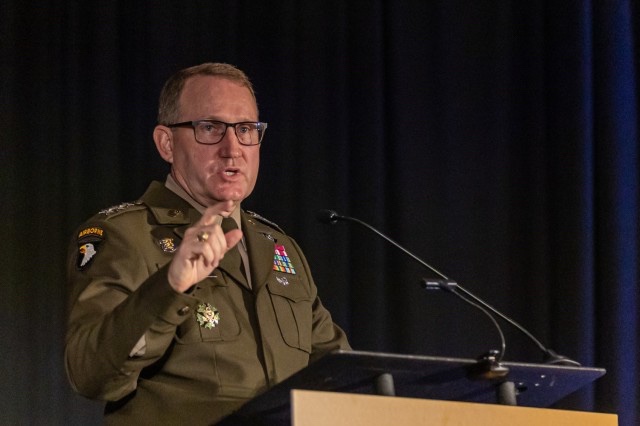
AUSTIN, Texas – “Our Soldiers, with our systems, must get accustomed to being constantly modernized,” said Lt. Gen. Thomas H. Todd III, Deputy Commanding General for Acquisition and Systems and Chief Innovation Officer at U.S. Army Futures Command (AFC).
Todd spoke about the importance of persistent modernization – which is intentionally designed to take place “now and often” – to a full audience of defense industry experts and innovators on Wednesday as part of the 2022 NDIA Future Force Capabilities Conference and Exhibition in Austin.
The event, hosted by the National Defense Industrial Association, provided participants an opportunity to learn about new developments in future-focused defense capabilities while also engaging with fellow defense professionals.
Todd’s keynote address highlighted the Army’s work to increase speed, range and convergence on the future battlefield, including by expertly harnessing and incorporating rapidly evolving warfighting technologies.
“We love to get after what’s next – constantly,” Todd said.
AFC, headquartered in Austin, surveys, develops and validates integrated concepts, models, simulations and technologies in order to steer future Army investments and ideas, Todd explained.
The command additionally serves as “lead trail boss” for multiple signature modernization efforts, furthering achievements through research, analysis and synchronization conducted by its Futures and Concepts Center, Combat Capabilities Development Command and Cross-Functional Teams, among other organizations.
“We are the operational architect,” Todd said, noting AFC coordinates closely with other Army commands and with the Office of the United States Assistant Secretary of the Army for Acquisition, Logistics and Technology and other partners to advance Army tools and systems.
Underpinning these activities, Army Futures Command leverages artificial intelligence, autonomy, sensors, robotics, synthetic biology, materials by design, additive manufacturing and other nascent technologies.
Exploration of human-machine teaming, which enables operational advantages on the ground and in the air by deliberately pairing human adaptability and intuition with machine speed and precision, is also proving integral to Army modernization.
“Let humans be good at what humans are good at; let robots be good at what robots are good at,” Todd asserted.
Meeting future warfighting demands, including the rigors of Multi-Domain Operations and the necessity of Joint interoperability, requires the active participation of industry, which is why events such as the NDIA-hosted conference function as productive platforms for information sharing and idea generation.
“We can no longer afford to be episodic; we have to be persistent,” Todd reiterated to audience members.
“Without you, we can’t achieve this.”
By Maureena Thompson, Army Futures Command


Modernization doesn’t occur at the Corps or below. There are 162 other problems a given company/battery/troop has that Big Army’s few new items still won’t fix.
Well, great. When does the FCS replace the Brad? The Crusader the M109? How is that new radio program going? How about that awesome Counter Defilade Target Engagement System?
How many billions is the Army going to flush down the toilet over the next five years of being ‘constantly modernized’? “It’s great, we never actually have to make anything work because we can say ‘that’s in the next spiral’ and get promoted and move on from this FUBAR program we created before anyone figures it out. And after one or two more programs we can retire to make millions at one of the primes we gave billions in exchange for prototypes that only worked in powerpoint.”